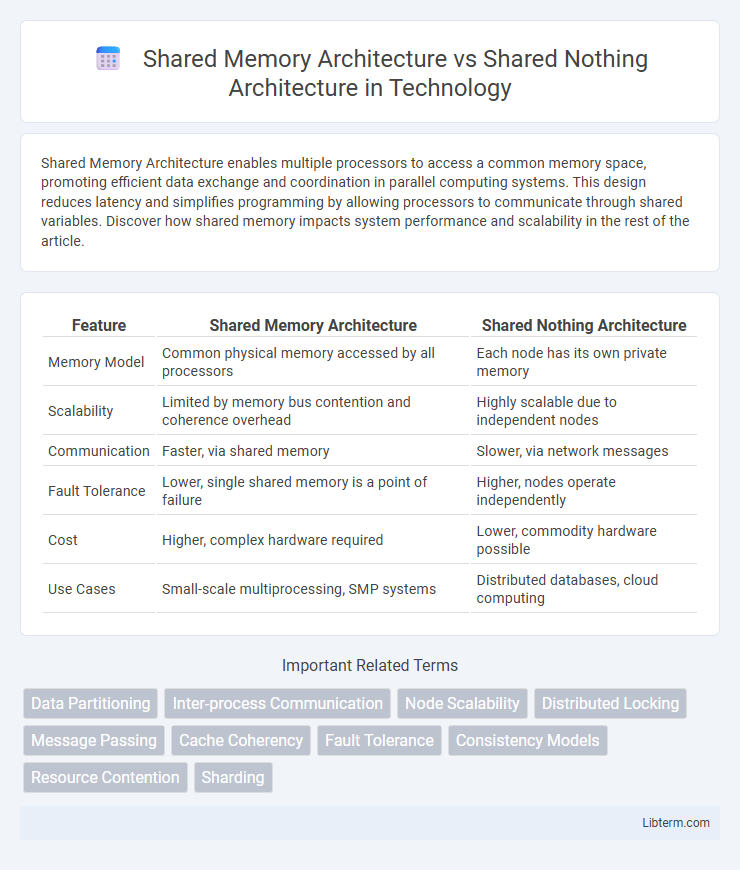Shared Memory Architecture enables multiple processors to access a common memory space, promoting efficient data exchange and coordination in parallel computing systems. This design reduces latency and simplifies programming by allowing processors to communicate through shared variables. Discover how shared memory impacts system performance and scalability in the rest of the article.
Table of Comparison
| Feature | Shared Memory Architecture | Shared Nothing Architecture |
|---|---|---|
| Memory Model | Common physical memory accessed by all processors | Each node has its own private memory |
| Scalability | Limited by memory bus contention and coherence overhead | Highly scalable due to independent nodes |
| Communication | Faster, via shared memory | Slower, via network messages |
| Fault Tolerance | Lower, single shared memory is a point of failure | Higher, nodes operate independently |
| Cost | Higher, complex hardware required | Lower, commodity hardware possible |
| Use Cases | Small-scale multiprocessing, SMP systems | Distributed databases, cloud computing |
Introduction to Parallel Computing Architectures
Shared Memory Architecture allows multiple processors to access a common memory space, enabling efficient communication and data sharing in parallel computing systems. Shared Nothing Architecture distributes memory across processors, each with its own private memory, enhancing scalability and fault tolerance by minimizing contention and bottlenecks. Parallel computing architectures leverage these models to optimize performance based on workload characteristics, communication overhead, and system design requirements.
What is Shared Memory Architecture?
Shared Memory Architecture is a computer architecture where multiple processors access a single, centralized memory pool, enabling efficient communication and data sharing through a common address space. This design facilitates faster inter-processor communication and simplifies programming models by allowing direct memory access, but it can face scalability bottlenecks due to contention and memory bandwidth limitations. Shared Memory systems are commonly used in multicore processors and symmetric multiprocessing (SMP) environments to enhance performance for parallel processing tasks.
What is Shared Nothing Architecture?
Shared Nothing Architecture is a distributed computing system design where each node operates independently with its own private memory and disk storage, eliminating resource contention. This architecture enhances scalability and fault tolerance by avoiding bottlenecks associated with shared resources, making it ideal for large-scale data processing and distributed databases. Systems like Google's Bigtable and Apache Cassandra utilize Shared Nothing Architecture to efficiently manage massive datasets across multiple servers.
Core Principles of Shared Memory vs Shared Nothing
Shared Memory Architecture centralizes memory access, allowing multiple processors to directly read and write to a common memory space, which facilitates faster communication and easier data sharing but can lead to contention and scalability issues. Shared Nothing Architecture distributes data and processing power across independent nodes, each with its own memory and disk, eliminating memory bottlenecks and improving fault tolerance while requiring sophisticated coordination for data consistency. The core principle of Shared Memory focuses on tight coupling with low-latency memory access, whereas Shared Nothing emphasizes loose coupling and scalability through distributed resources.
Performance Comparison: Shared Memory vs Shared Nothing
Shared Memory Architecture offers low-latency data access by enabling multiple processors to share a common memory space, resulting in faster communication and synchronization for workloads requiring intensive data sharing. Shared Nothing Architecture scales horizontally by partitioning data and processing across independent nodes, minimizing contention and enabling high throughput under distributed workloads but with increased communication overhead. Performance in Shared Memory excels for tightly coupled, memory-intensive tasks, whereas Shared Nothing achieves superior scalability and fault tolerance for large-scale distributed systems.
Scalability Challenges and Solutions
Shared Memory Architecture faces scalability challenges due to memory contention and limited bus bandwidth, causing bottlenecks as the number of processors increases. Shared Nothing Architecture overcomes these issues by distributing data and processing across independent nodes with local memory, enabling linear scalability. Solutions for Shared Memory include implementing cache coherence protocols and NUMA designs, while Shared Nothing employs data partitioning and distributed transaction management to maintain performance at scale.
Fault Tolerance and Reliability Considerations
Shared Memory Architecture centralizes data storage, making fault tolerance reliant on robust memory management and error-checking mechanisms to prevent system-wide failures. Shared Nothing Architecture enhances fault tolerance and reliability by isolating failures within individual nodes, allowing other nodes to continue operation uninterrupted and simplifying recovery processes. Distributed data replication and redundancy strategies further strengthen reliability in Shared Nothing systems by minimizing data loss risks during node failures.
Use Cases: When to Choose Each Architecture
Shared Memory Architecture suits applications requiring fast, low-latency data sharing and tight coupling, such as real-time processing, in-memory databases, and high-performance computing clusters. Shared Nothing Architecture excels in scalable, distributed systems with fault tolerance needs like large-scale web services, data warehousing, and cloud-native applications. Choosing between them hinges on workload characteristics: shared memory for low-latency, tightly coupled tasks; shared nothing for horizontal scalability and fault isolation.
Real-World Examples and Applications
Shared memory architecture is commonly used in systems like Symmetric Multiprocessing (SMP) servers, enabling multiple processors to access the same memory space for tasks such as in-memory databases and real-time analytics platforms like SAP HANA. Shared nothing architecture is exemplified by distributed databases such as Apache Cassandra and NoSQL stores like MongoDB, where nodes operate independently with separate memory and storage, optimizing scalability and fault tolerance for large-scale web applications and cloud services. Companies like Facebook and Google leverage shared nothing systems to handle massive, geographically distributed data workloads, while traditional enterprise resource planning (ERP) systems often rely on shared memory designs for tighter process synchronization.
Future Trends in Computing Architectures
Future trends in computing architectures emphasize enhanced scalability and efficiency, positioning Shared Nothing Architecture as a strong candidate due to its decentralized data storage and fault tolerance capabilities. Advances in hardware, including non-volatile memory and high-speed interconnects, are enabling hybrid models that combine Shared Memory Architecture's low latency with Shared Nothing Architecture's scalability. Emerging applications in big data analytics, cloud computing, and distributed databases leverage these architectures to optimize performance and resource utilization in increasingly complex and data-intensive environments.
Shared Memory Architecture Infographic

 libterm.com
libterm.com